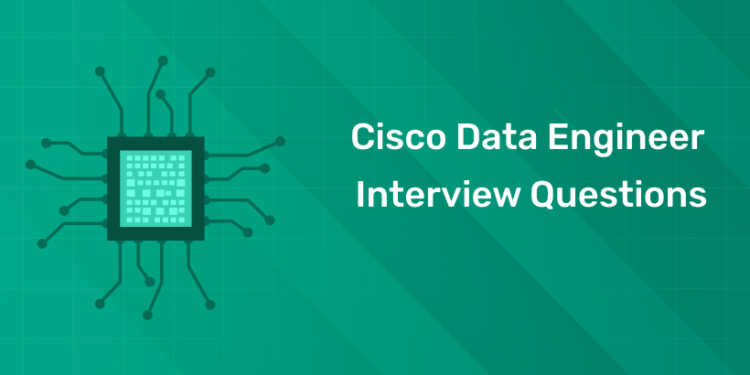Cisco Data Engineer Interview Questions
Why Join Cisco?
Cisco offers a great work environment for tech professionals, including Data Engineers. Here’s why Cisco could be the right company for you:
1. Reputation as a Tech Leader
Cisco is renowned for shaping the future of networking and cybersecurity. As a Data Engineer at Cisco, you’ll work with state-of-the-art technologies and be part of a global team driving innovation.
2. Great Work Culture and Benefits
- Cutting-edge technology: Cisco encourages innovation and adopts the latest tech trends, including big data, AI, and cloud computing.
- Career growth opportunities: Cisco promotes from within and supports learning through certifications and training.
- Competitive salary and benefits: Cisco offers attractive compensation packages, including health benefits, stock options, and bonuses.
- Diversity and inclusion: Cisco fosters an inclusive workplace where employees are valued for their contributions.
3. Work-Life Balance
Cisco emphasizes work-life balance through flexible working hours, remote work options, and employee well-being initiatives.
Cisco Interview Preparation Tips
Cisco’s interview process can be rigorous, so preparation is key. Here’s how to get ready:
1. Know Cisco’s Hiring Process
Cisco’s interview process usually consists of:
- Phone Screen: Initial call with a recruiter to discuss your experience.
- Technical Interviews: You’ll solve coding problems, data engineering questions, and discuss system designs.
- Behavioral Interviews: Cisco focuses on teamwork, communication, and how you handle challenges.
- Final Interviews: These may involve senior engineers or managers for a deeper technical and cultural fit evaluation.
2. How to Prepare for Cisco Interviews
- Research Cisco’s Data Ecosystem: Understand Cisco’s products and how data engineering fits within the company.
- Brush Up on Fundamentals: Focus on data structures, algorithms, SQL, ETL, and cloud platforms.
- Practice Coding: Use platforms like LeetCode or HackerRank to practice coding challenges.
- Mock Interviews: Simulate real interviews with friends or use mock interview platforms.
Click here to ace Cisco Data Engineer Interview Questions by learning the fundamentals!
Top Cisco Data Engineer Interview Questions and Answers
We’ve categorized the questions into three sections: technical, scenario-based, and behavioral.
1. Technical Questions
These questions assess your understanding of data engineering concepts and tools. You’ll need to be familiar with programming, databases, and big data frameworks.
1.1. Explain the difference between SQL and NoSQL databases.
Answer:
SQL databases are relational, table-based systems like MySQL, while NoSQL databases are non-relational, designed for scalability, like MongoDB. SQL is better for structured data, while NoSQL handles large volumes of unstructured or semi-structured data.
1.2. What is ETL, and why is it important?
Answer:
ETL stands for Extract, Transform, Load. It’s the process of extracting data from different sources, transforming it into a usable format, and loading it into a destination, like a data warehouse. ETL is critical for making data analysis-ready.
1.3. How do you optimize a slow SQL query?
Answer:
You can optimize a slow query by:
- Indexing columns used in WHERE and JOIN clauses.
- Reducing the data processed (e.g., using LIMIT).
- Analyzing the query execution plan to identify bottlenecks.
1.4. Explain data normalization and denormalization.
Answer:
Normalization minimizes data redundancy by dividing tables into smaller ones. Denormalization combines tables to optimize query performance, at the cost of some redundancy.
1.5. What is a distributed system, and how does it relate to big data?
Answer:
A distributed system consists of multiple connected computers working together. It’s essential for big data because it processes large datasets across multiple machines, improving scalability and fault tolerance.
1.6. How would you handle missing or corrupted data in a dataset?
Answer:
Strategies include:
- Imputation: Filling in missing values with averages or most common values.
- Dropping records: Removing rows with missing data if they’re not critical.
- Flagging data: Mark missing or corrupted data to handle it separately in analysis.
1.7. What are window functions in SQL?
Answer:
Window functions perform calculations across rows related to the current row within a window of rows. Examples include RANK(), ROW_NUMBER(), and SUM() for cumulative calculations.
1.8. Describe how you would implement a data pipeline for real-time data processing.
Answer:
A real-time data pipeline can use tools like Kafka for data ingestion, Spark Streaming for real-time processing, and store data in a scalable storage system like Amazon S3 or Hadoop HDFS.
1.9. What is MapReduce?
Answer:
MapReduce is a programming model used for processing large datasets. The Map function processes input data and generates key-value pairs, while the Reduce function aggregates the results from the Map phase.
1.10. How do you ensure data integrity in data pipelines?
Answer:
Data integrity can be maintained by:
- Validating data at every stage.
- Using checksums or hash functions.
- Monitoring logs to identify errors early.
1.11. Explain sharding in databases.
Answer:
Sharding is a database partitioning technique that splits large databases into smaller, manageable pieces across multiple servers, enhancing scalability and performance.
1.12. What are the common data structures used in data engineering?
Answer:
Common data structures include:
- Arrays and lists for ordered data.
- Hash tables for fast key-value lookups.
- Trees and graphs for hierarchical and relational data.
1.13. How do you manage schema changes in a live database?
Answer:
Schema changes should be rolled out gradually, tested in staging environments, and carefully synchronized with application changes to avoid disruptions.
1.14. What is the role of Apache Kafka in real-time data processing?
Answer:
Kafka is a distributed streaming platform that ingests, stores, and processes real-time data streams efficiently, supporting high-throughput event streaming applications.
1.15. What is the difference between OLTP and OLAP?
Answer:
OLTP (Online Transaction Processing) is designed for handling high-volume transactional data, while OLAP (Online Analytical Processing) is optimized for complex analytical queries on historical data.
1.16. What are some best practices for designing a scalable data architecture?
Answer:
Best practices include:
- Using distributed computing for scalability (e.g., Hadoop, Spark).
- Partitioning data to improve performance.
- Using cloud solutions for elasticity.
- Automating ETL processes to ensure data freshness.
1.17. How do you handle schema evolution in a NoSQL database?
Answer:
NoSQL databases allow for flexible schema design. I’d use backward-compatible changes, versioning, and ensure that the application can handle different versions of the schema without breaking.
1.18. How do you ensure the security of data during transit and at rest?
Answer:
I’d use encryption techniques (TLS for data in transit, AES for data at rest), implement access controls, and ensure that sensitive data is masked or anonymized where appropriate.
2. Scenario-Based Questions
These questions test your ability to solve real-world problems. They assess how you approach challenges, optimize data workflows, and design scalable systems.
2.1. How would you design a scalable data pipeline for a company with rapidly growing data?
Answer:
I would design a scalable data pipeline by:
- Using distributed systems like Hadoop or Spark.
- Implementing automated ETL processes.
- Storing data in a cloud data warehouse like Redshift or BigQuery.
- Regularly monitoring and optimizing pipeline performance.
2.2. How would you troubleshoot an ETL job that’s taking too long?
Answer:
I’d analyze the bottleneck, optimize SQL queries, break the job into smaller parallel tasks, and improve data partitioning and indexing.
2.3. How do you handle data inconsistencies between two sources feeding into the same data warehouse?
Answer:
I would:
- Profile both datasets to identify inconsistencies.
- Apply standard transformation rules.
- Use validation checks to catch inconsistencies early.
2.4. How would you manage an out-of-memory error in a Spark job?
Answer:
I’d increase executor memory, optimize shuffling operations, reduce task size, and repartition the dataset to distribute the workload more evenly.
2.5. How do you secure sensitive data in a data pipeline?
Answer:
Security measures include:
- Encrypting data in transit and at rest.
- Implementing access control mechanisms.
- Masking sensitive data during processing.
- Monitoring for unauthorized access.
2.6. How do you design a fault-tolerant data pipeline?
Answer:
A fault-tolerant pipeline should:
- Replicate data across nodes.
- Use checkpointing to recover from failures.
- Include retry mechanisms for transient errors.
- Monitor pipeline health and alert teams in case of failures.
2.7. How do you ensure real-time fraud detection in an e-commerce system?
Answer:
I’d use real-time data ingestion tools like Kafka, process transactions with stream-processing frameworks like Apache Flink, and implement machine learning models for anomaly detection.
2.8. Describe how you would optimize a data migration process.
Answer:
I’d ensure compatibility between old and new systems, automate the migration process using tools like AWS DMS, and conduct thorough testing before and after the migration.
2.9. How do you manage large datasets efficiently in a cloud environment?
Answer:
By using cloud-native tools like AWS S3 for storage, setting up scalable databases like Redshift, and leveraging auto-scaling features to manage traffic spikes.
2.10. How would you deal with schema evolution in a NoSQL database?
Answer:
I’d implement versioning in schema design, use backward-compatible changes, and ensure the application handles both old and new schema versions.
2.11. How would you handle the failure of a critical ETL job in production?
Answer:
I’d first review logs to diagnose the issue, apply a temporary fix, and reprocess the failed job, while ensuring proper notification to stakeholders.
2.12. How do you design a data warehouse for fast querying in a reporting system?
Answer:
I’d:
- Use denormalization for fast reads.
- Implement materialized views and partitioning.
- Optimize indexing based on frequently queried columns.
2.13. How do you handle duplicate records in a large dataset?
Answer:
Use deduplication techniques like DISTINCT in SQL or hash functions to identify and remove duplicates during the ETL process.
2.14. How do you monitor and maintain the performance of a data pipeline?
Answer:
I’d set up real-time monitoring with tools like Grafana, implement logging and alerting systems, and regularly optimize pipeline performance based on metrics like throughput and latency.
2.15. How do you handle real-time data validation in a pipeline?
Answer:
Implement validation checks at each stage of the pipeline, use data profiling tools to catch errors early, and create automated alerts for anomalies.
2.16. Describe a time when you optimized a slow-running query. What steps did you take?
Answer:
I optimized a query by analyzing the execution plan, indexing the right columns, reducing unnecessary joins, and partitioning the table to improve performance.
2.17. How would you design a data architecture for a company handling petabytes of data?
Answer:
I’d use distributed computing with tools like Hadoop or Spark, ensure horizontal scaling, partition data for efficient access, and implement cloud storage for scalability.
3. Behavioral Questions
Cisco values teamwork, communication, and adaptability. These questions assess how well you fit into the company’s culture and handle interpersonal challenges.
3.1. Tell me about a time when you had to work under pressure.
Answer:
I managed a project with a tight deadline by breaking down tasks, prioritizing the most critical ones, and collaborating closely with my team to ensure everything was delivered on time.
3.2. How do you handle feedback from peers or managers?
Answer:
I appreciate constructive feedback, as it helps me grow. I reflect on the feedback, ask clarifying questions, and implement changes where necessary.
3.3. Describe a time when you resolved a conflict within a team.
Answer:
I mediated between two team members by listening to both sides, finding common ground, and suggesting a compromise that aligned with the project’s goals.
3.4. How do you prioritize tasks when handling multiple projects?
Answer:
I prioritize based on urgency and impact, and I use tools like Trello to manage tasks efficiently. I communicate with stakeholders to ensure everyone is on the same page regarding deadlines.
3.5. Give an example of a time when you had to explain a technical concept to a non-technical audience.
Answer:
I used simple analogies and visuals to explain the concept of data pipelines to a business team, focusing on the value it brought to their reporting and decision-making processes.
3.6. How do you adapt to changing requirements in a project?
Answer:
I stay flexible by regularly communicating with stakeholders and adjusting my approach based on new priorities or feedback. I ensure that I can deliver the required changes without sacrificing quality.
3.7. Describe a situation where you had to learn a new tool or technology quickly.
Answer:
When we adopted Spark, I quickly took an online course, practiced with small projects, and applied my new knowledge to optimize our ETL processes within a few weeks.
3.8. How do you ensure effective communication when working remotely?
Answer:
I maintain clear communication through regular check-ins, use collaborative tools like Slack, and ensure that documentation is updated and shared with the team.
3.9. How do you handle mistakes in your work?
Answer:
I take ownership of mistakes, quickly correct them, and learn from the experience to avoid similar issues in the future.
3.10. Tell me about a time when you led a project.
Answer:
I led a data migration project by setting clear milestones, delegating tasks based on team strengths, and keeping everyone on track with regular updates.
3.11. How do you handle disagreements within a team?
Answer:
I promote open communication by encouraging team members to share their viewpoints. I then facilitate a constructive discussion to arrive at a mutually agreeable solution.
3.12. How do you manage your time when working on multiple priorities?
Answer:
I prioritize tasks based on deadlines and impact. I break larger tasks into smaller, more manageable steps, and use time management tools to stay organized and on schedule.
Additional Tips for Success
- Stay updated: Keep learning about new Cisco technologies and the latest advancements in data engineering.
- Practice coding: Regularly solve coding problems on LeetCode or HackerRank to stay sharp.
- Network: Reach out to Cisco employees on LinkedIn for insights on the interview process and company culture.
Click here to ace Cisco Data Engineer Interview Questions by learning the fundamentals!
Cisco Data Engineer Interview Questions: Conclusion
A Data Engineer role at Cisco offers the chance to work with innovative technologies and be part of a global leader in tech. By preparing for technical, scenario-based, and behavioral questions, you’ll be well-equipped for the interview process. Stay confident, practice regularly, and you’ll be ready to succeed.












